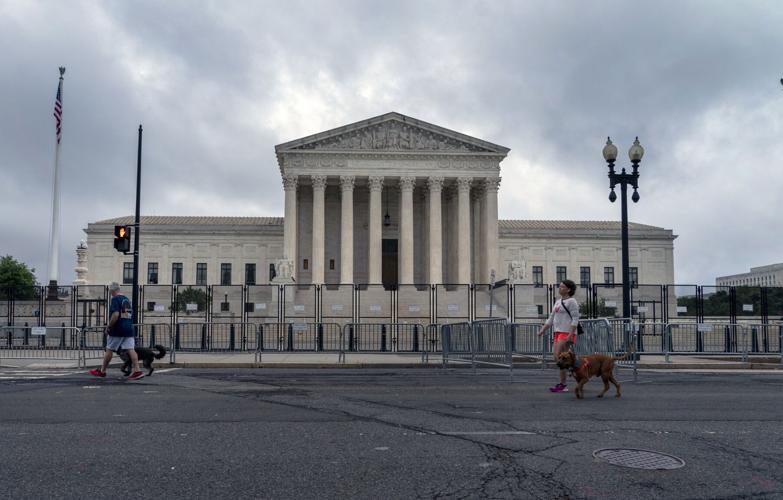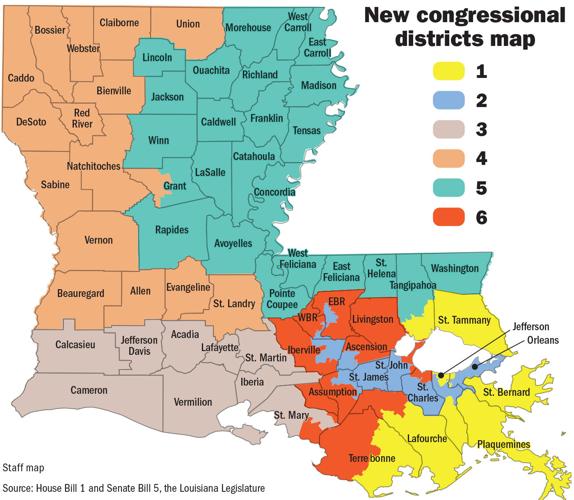The congressional district map approved by the Louisiana Legislature in February will stand for the November elections, after the U.S. Supreme Court on Tuesday delayed a Baton Rouge federal judge's effort to reorganize voters into districts that give minorities a better opportunity to elect two of their own to the U.S. Congress instead of only one.
In a one-page order, the high court stayed the federal lawsuit filed by minority voters in Louisiana until after the justices decide a similar challenge in Alabama. Justices Stephen Breyer, Sonia Sotomayor and Elena Kagan — who generally adopt liberal positions on the Supreme Court — opposed the majority’s decision.
The congressional elections scheduled for November will use the maps approved by the Republican-majority Legislature, which also overrode Democratic Gov. John Bel Edwards’ veto of those maps.
“We’re going to use the current maps; that’s how I interpret this,” said House and Governmental Affairs Committee Chair John Stefanski, the Crowley Republican in charge of redistricting for the lower chamber.
The stay applies to the federal district court, which had scheduled a hearing for Wednesday, and to the 5th U.S. Circuit Court of Appeals, which had scheduled a hearing on July 8.
U.S. District Judge Shelly Dick, of Baton Rouge, ruled June 6 that the maps approved by the Legislature failed to meet the standards of the federal Voting Rights Act of 1965 by diluting Black voices in the running of government.
Dick found that the Legislature packed Black voters into one of Louisiana’s six congressional districts and in the other five divided Black neighborhoods in a way that scattered minority voters in overwhelmingly White districts.
However, enough voting-age Black people live close enough together along the Mississippi River and in Baton Rouge that two districts could be drawn with modest majorities of minority voters, she found. No Black candidate has ever been elected from a White district in modern history in Louisiana.
Under an order by Dick, legislators returned to Baton Rouge in a special session earlier this month to attempt to draw a congressional map with two “minority opportunity” districts but failed to do so. Dick scheduled a hearing Wednesday to reveal how she would redraw the maps, which would have been used in the November elections.
Edwards said in a statement he was disappointed with the Supreme Court ruling, saying Dick’s “well-reasoned 157-page decision clearly demonstrated that the maps passed by the Legislature do not comply with Section 2 of the Voting Rights Act.”
“Black Louisianans make up one-third of our population, and one-third of our districts should be majority Black when such a map can be drawn and, as has been clearly demonstrated, that map is more compact, better adheres to the legal principles governing redistricting, and will perform,” he said.
House Speaker Clay Schexnayder, the Gonzales Republican whose bill the Legislature adopted, countered: “Like I’ve said this entire time, the special session to redraw congressional maps was premature and unnecessary. I look forward to the Supreme Court ruling our map to be constitutional and fair.”
Legislative leaders counter that their maps drawn a few months ago — with five overwhelmingly White districts and one Black — were just tweaks to the voting districts approved a decade ago.
The new maps received two-thirds majority support when lawmakers in March overrode Edwards’ veto, the Republican leadership points out. They argue Dick overstepped her federal authority on a state function by improperly finding that the Voting Rights Act standards had been breached.
“I am very pleased that the U.S. Supreme Court agreed to halt the chaos created by Judge Dick's earlier order & is allowing Louisiana's congressional races to proceed with the map enacted by the legislature, which we have always maintained is constitutional," Slidell Republican Sen. Sharon Hewitt said in a tweet. As chair to the Senate and Governmental Affairs Committee, she oversaw the redistricting effort for the upper chamber.
Sen. Cleo Fields, D-Baton Rouge, who sponsored one of the maps that would add a second majority-Black congressional district, called the ruling “disappointing but not surprising.”
“The Supreme Court appears to be getting more political; that is pretty unfortunate,” Fields said. “But it is the highest court in the land, and I am going to accept the opinion of the highest court.”
Edgar Cage, a New Orleans plaintiff who challenged the validity of the Republican majority's congressional maps, said: “Our Legislature had enough time and opportunity to come up with a second minority district and refused to do it.”
The lawsuit that led to Dick’s ruling argues that the map passed by the Legislature continues Louisiana’s “long history of maximizing political power for White citizens by disenfranchising and discriminating against Black Louisianans.”
It notes that while Black residents make up 31.2% of the state’s voting-age population, Black voters control only around 17% of the state’s congressional districts. Meanwhile, White voters, who make up 58% of the population, form a majority in 83% — or five of six — districts.
Decades ago, the U.S. Supreme Court established a test to determine whether a districting plan violates Section 2 of the federal Voting Rights Act of 1965.
Plaintiffs must prove that the minority population is “sufficiently large and geographically compact” to support a map with a second majority-minority district. They also must prove that Black voters are “politically cohesive” and that White voters tend to vote as a bloc to defeat candidates preferred by Black voters.
About a dozen similar redistricting challenges in other states are percolating through the federal trial and appellate process. The only case the U.S. Supreme Court has weighed in on had been in Alabama, where minority voters also sought in court another minority opportunity congressional district. That was denied in the maps enacted by state’s GOP majority. The high court stayed lower court orders that Alabama legislators return to the drawing board, saying the ruling came only a few days before qualifying began. Argument is set for Oct. 4 before the Supreme Court.
Rep. Royce Duplessis, the New Orleans Democrat who is vice chair on Stefanski’s House and Governmental Affairs Committee, interpreted the high court’s move as a way to consider the constitutionality of the Voting Rights Act, which has protected minority voters for 57 years.
“Given the recent rulings of this court, I am very concerned,” he said.
Staff writer Will Sentell contributed to this report.





